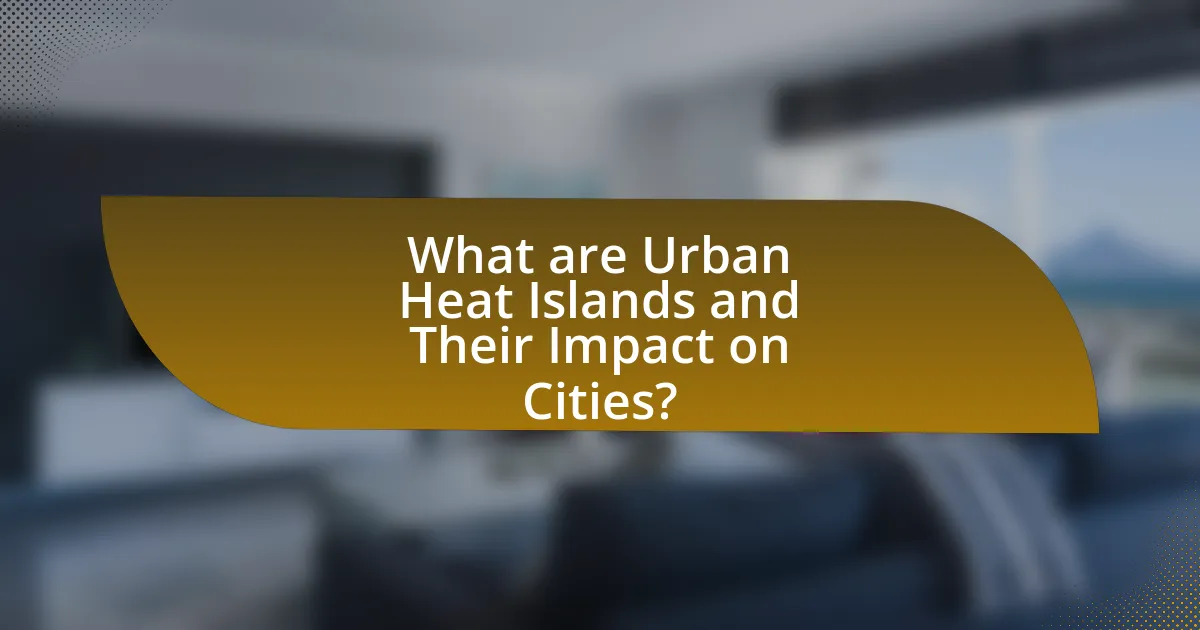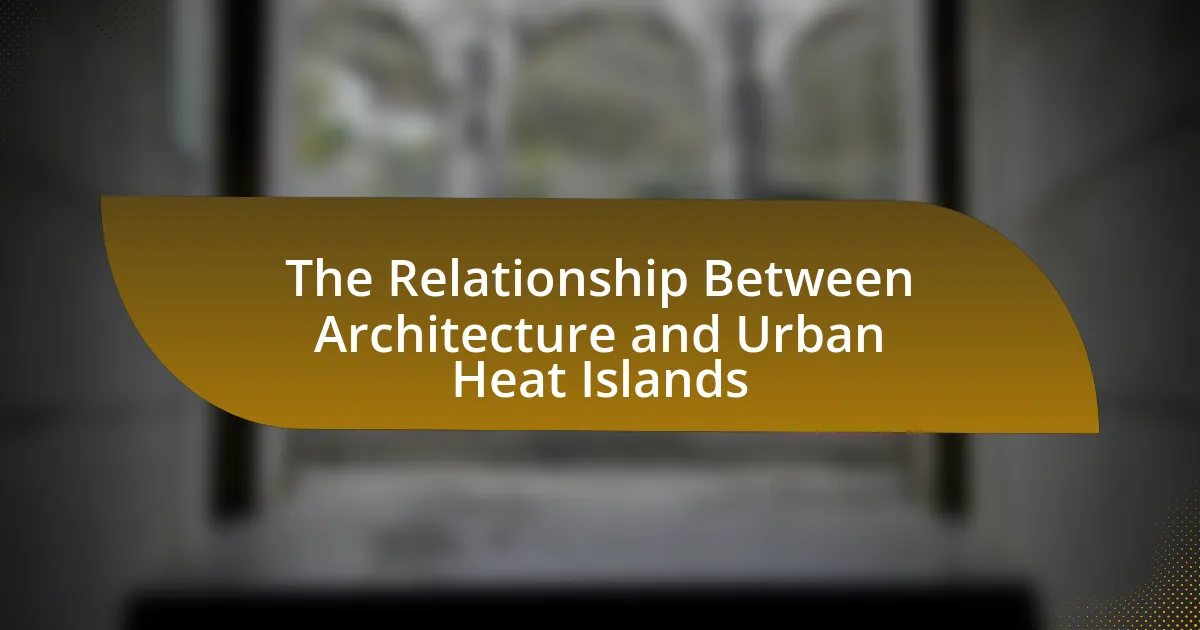Urban Heat Islands (UHIs) are urban areas that experience higher temperatures than their rural surroundings due to human activities and land surface modifications. This article explores the formation of UHIs, the factors contributing to their development, and their significant impacts on energy consumption, health risks, and local climates. It also examines how architectural design, including building materials and height, influences temperature variations and discusses strategies for mitigating UHIs through sustainable practices such as green roofs, reflective materials, and increased vegetation. The role of community involvement in addressing UHIs is highlighted as a crucial element in implementing effective cooling measures.

What are Urban Heat Islands and Their Impact on Cities?
Urban Heat Islands (UHIs) are urban areas that experience significantly higher temperatures than their rural surroundings due to human activities and modifications to land surfaces. This phenomenon occurs because urban environments often have more concrete, asphalt, and buildings that absorb and retain heat, leading to elevated temperatures, especially during the day and at night.
The impact of UHIs on cities includes increased energy consumption for cooling, elevated emissions of air pollutants and greenhouse gases, and heightened health risks for residents, particularly vulnerable populations. Studies indicate that urban areas can be 2 to 5 degrees Fahrenheit warmer than nearby rural areas, which can exacerbate heat-related illnesses and mortality rates during heatwaves. Additionally, UHIs can affect local weather patterns and contribute to increased rainfall in urban areas due to enhanced convection processes.
How do Urban Heat Islands form in urban environments?
Urban Heat Islands form in urban environments primarily due to the concentration of buildings, roads, and other infrastructure that absorb and retain heat. These materials, such as concrete and asphalt, have a lower albedo compared to natural landscapes, meaning they reflect less sunlight and absorb more heat. Additionally, human activities, including transportation and industrial processes, contribute to increased temperatures through the release of heat and pollutants. Studies indicate that urban areas can be 2 to 5 degrees Fahrenheit warmer than surrounding rural areas, particularly during the night when heat is released from buildings and surfaces. This phenomenon is exacerbated by limited vegetation, which reduces cooling through shade and evapotranspiration.
What factors contribute to the development of Urban Heat Islands?
Urban Heat Islands develop primarily due to human activities and urbanization, which lead to increased temperatures in metropolitan areas compared to their rural surroundings. Key factors include the extensive use of concrete and asphalt, which absorb and retain heat; the reduction of vegetation, which diminishes natural cooling through shade and evapotranspiration; and the concentration of buildings and infrastructure that trap heat. According to a study by the U.S. Environmental Protection Agency, urban areas can be 2 to 5 degrees Fahrenheit warmer than surrounding rural areas, highlighting the significant impact of these factors on local climates.
How do different land surfaces affect temperature variations in cities?
Different land surfaces significantly affect temperature variations in cities by influencing heat absorption and retention. Urban areas with concrete and asphalt surfaces tend to absorb more heat during the day and release it slowly at night, leading to higher temperatures, a phenomenon known as the urban heat island effect. In contrast, vegetation and water bodies have a cooling effect due to evapotranspiration and lower heat retention. Studies show that areas with more green spaces can be up to 5 degrees Celsius cooler than those dominated by impervious surfaces. This temperature differential is crucial for urban planning and mitigating heat-related issues in densely populated areas.
What are the consequences of Urban Heat Islands on urban living?
Urban Heat Islands (UHIs) significantly increase temperatures in urban areas compared to their rural surroundings, leading to various adverse consequences for urban living. These elevated temperatures can exacerbate heat-related health issues, such as heat exhaustion and heat stroke, particularly affecting vulnerable populations like the elderly and those with pre-existing health conditions.
Additionally, UHIs contribute to increased energy consumption as residents rely more on air conditioning to maintain comfortable indoor temperatures, resulting in higher electricity bills and greater greenhouse gas emissions. Research indicates that cities can experience temperature increases of 1 to 7 degrees Fahrenheit due to UHIs, which can lead to a rise in ground-level ozone pollution, further impacting air quality and respiratory health.
Moreover, UHIs can negatively affect water quality by raising the temperature of stormwater runoff, which can harm aquatic ecosystems. The combination of these factors underscores the critical need for urban planning and architectural strategies that mitigate the effects of Urban Heat Islands, such as increasing vegetation, implementing green roofs, and using reflective materials in construction.
How do Urban Heat Islands influence energy consumption in cities?
Urban Heat Islands (UHIs) significantly increase energy consumption in cities by raising temperatures, which leads to higher demand for air conditioning and cooling systems. Research indicates that urban areas can be 2 to 5 degrees Fahrenheit warmer than their rural surroundings, resulting in a 10-20% increase in energy use for cooling during peak summer months. This heightened energy demand not only strains electrical grids but also contributes to increased greenhouse gas emissions, as many cities rely on fossil fuels for electricity generation. Studies, such as those conducted by the U.S. Environmental Protection Agency, have shown that mitigating UHI effects through urban planning and green infrastructure can reduce energy consumption and improve overall urban sustainability.
What health risks are associated with Urban Heat Islands?
Urban Heat Islands (UHIs) pose significant health risks, primarily by increasing heat-related illnesses and mortality rates. Elevated temperatures in urban areas can exacerbate conditions such as heat exhaustion, heat stroke, and cardiovascular issues, particularly among vulnerable populations like the elderly and those with pre-existing health conditions. Research indicates that cities can be up to 5°F warmer than surrounding rural areas, leading to a higher incidence of heat-related emergencies. For instance, a study published in the journal Environmental Health Perspectives found that UHI effects can increase mortality rates by 2% for every degree Fahrenheit increase in temperature during heat waves. Additionally, UHIs can worsen air quality, contributing to respiratory problems due to higher levels of pollutants and allergens.

How Does Architecture Influence Urban Heat Islands?
Architecture significantly influences urban heat islands by affecting the absorption and retention of heat in urban environments. Buildings with dark materials and limited vegetation increase heat absorption, while high-density structures can trap heat, leading to elevated temperatures in urban areas. For instance, studies show that urban areas can be 2 to 5 degrees Celsius warmer than surrounding rural areas due to these architectural choices. Additionally, the design of buildings, including their height and spacing, impacts airflow and sunlight exposure, further exacerbating heat retention.
What architectural features exacerbate Urban Heat Islands?
Impervious surfaces, such as asphalt and concrete, exacerbate Urban Heat Islands by absorbing and retaining heat. These materials have low albedo, meaning they reflect less sunlight and instead convert it into heat, raising local temperatures. Additionally, the lack of vegetation in urban areas leads to reduced evapotranspiration, which further contributes to heat retention. Studies indicate that urban areas can be 2 to 5 degrees Fahrenheit warmer than surrounding rural areas due to these architectural features.
How do building materials affect heat absorption and retention?
Building materials significantly influence heat absorption and retention due to their thermal properties. Materials such as concrete and asphalt have high thermal mass, allowing them to absorb and store heat during the day and release it slowly at night, which contributes to the urban heat island effect. Conversely, lighter materials like wood or reflective surfaces can reduce heat absorption, leading to lower retention and cooler surface temperatures. Research indicates that dark-colored surfaces can increase surface temperatures by up to 20 degrees Fahrenheit compared to lighter surfaces, demonstrating the impact of material choice on heat dynamics in urban environments.
What role does building height play in temperature variations?
Building height significantly influences temperature variations in urban environments. Taller buildings can create a phenomenon known as the urban heat island effect, where they trap heat and reduce airflow, leading to higher temperatures in their vicinity. Research indicates that cities with taller structures often experience elevated temperatures compared to areas with shorter buildings due to increased surface area for heat absorption and reduced shading. For instance, a study published in the journal “Environmental Science & Technology” found that urban areas with high-rise buildings can be up to 5 degrees Celsius warmer than surrounding rural areas, demonstrating the direct impact of building height on local temperature variations.
How can architectural design mitigate Urban Heat Islands?
Architectural design can mitigate Urban Heat Islands (UHIs) by incorporating reflective materials, green roofs, and strategic vegetation placement. Reflective materials, such as cool roofing and light-colored pavements, reduce heat absorption, leading to lower surface temperatures. Studies indicate that cool roofs can lower roof temperatures by up to 30% compared to traditional dark roofs, significantly reducing surrounding air temperatures. Green roofs provide insulation and evapotranspiration, which can lower ambient temperatures by up to 5 degrees Fahrenheit. Additionally, strategically placed trees and vegetation can provide shade and enhance cooling through transpiration, further decreasing heat accumulation in urban areas. These design strategies collectively contribute to a cooler urban environment, effectively addressing the UHI effect.
What are the benefits of green roofs and walls in urban settings?
Green roofs and walls provide significant benefits in urban settings by reducing the urban heat island effect, improving air quality, and enhancing biodiversity. These green installations lower surface and air temperatures through evapotranspiration and shading, which can decrease the need for air conditioning by up to 75%, as reported by the U.S. Environmental Protection Agency. Additionally, they filter pollutants from the air, contributing to better urban air quality, and support various plant and animal species, thus promoting urban biodiversity. Studies indicate that green roofs can absorb up to 80% of rainfall, mitigating stormwater runoff and reducing the risk of flooding in cities.
How does strategic landscaping contribute to cooling effects?
Strategic landscaping contributes to cooling effects by utilizing vegetation to reduce ambient temperatures through shade and evapotranspiration. Trees and plants absorb sunlight, providing shade that lowers surface temperatures and reduces heat absorption by buildings and pavement. Additionally, the process of evapotranspiration, where plants release moisture into the air, cools the surrounding environment. Research indicates that urban areas with increased greenery can experience temperature reductions of up to 5 degrees Fahrenheit compared to areas with minimal vegetation, demonstrating the effectiveness of strategic landscaping in mitigating urban heat islands.

What Strategies Can Be Implemented to Address Urban Heat Islands?
Strategies to address Urban Heat Islands include increasing vegetation through urban forestry, implementing green roofs, and utilizing reflective materials in building construction. Urban forestry can reduce surface and air temperatures by providing shade and enhancing evapotranspiration, as evidenced by studies showing that tree canopies can lower temperatures by up to 5 degrees Fahrenheit. Green roofs not only insulate buildings but also mitigate heat absorption, with research indicating they can reduce rooftop temperatures by 30-40%. Additionally, reflective materials, such as cool pavements and reflective roofing, can significantly decrease heat absorption, with some materials reflecting up to 80% of sunlight. These strategies collectively contribute to lowering urban temperatures and improving overall urban climate resilience.
What urban planning practices can reduce Urban Heat Islands?
Urban planning practices that can reduce Urban Heat Islands include increasing vegetation through urban forestry, implementing green roofs, and utilizing reflective materials in construction. Increasing vegetation, such as trees and parks, can lower surface and air temperatures by providing shade and through the process of evapotranspiration, which can reduce temperatures by up to 5 degrees Fahrenheit in urban areas. Green roofs, which are covered with vegetation, can also significantly lower building temperatures and reduce the heat absorbed by urban surfaces. Additionally, using reflective materials, such as cool pavements and light-colored roofing, can decrease heat absorption, leading to lower surface temperatures. Studies have shown that these practices can effectively mitigate the heat generated in urban environments, thereby improving overall urban climate resilience.
How can the integration of parks and green spaces help?
The integration of parks and green spaces can significantly mitigate urban heat islands by providing natural cooling effects. These areas reduce surface temperatures through shade and evapotranspiration, which can lower surrounding air temperatures by as much as 5 to 10 degrees Fahrenheit. Research conducted by the U.S. Environmental Protection Agency indicates that urban areas with increased vegetation can experience reduced heat-related health risks and improved air quality. Additionally, parks and green spaces enhance biodiversity, promote recreational opportunities, and improve overall urban aesthetics, contributing to healthier and more sustainable urban environments.
What policies can cities adopt to promote sustainable architecture?
Cities can adopt policies such as implementing green building codes, providing incentives for energy-efficient designs, and promoting the use of sustainable materials to promote sustainable architecture. Green building codes, like LEED certification, encourage developers to incorporate energy-efficient systems and sustainable practices, which can significantly reduce urban heat islands by minimizing heat absorption and promoting vegetation. Additionally, financial incentives, such as tax credits or grants for projects that meet sustainability criteria, can motivate architects and builders to prioritize eco-friendly designs. Furthermore, policies that mandate the use of reflective materials and green roofs can directly combat urban heat islands by reducing surface temperatures and enhancing urban biodiversity.
What are the best practices for architects to combat Urban Heat Islands?
Architects can combat Urban Heat Islands by implementing green roofs, using reflective materials, and increasing vegetation in urban designs. Green roofs reduce heat absorption by providing insulation and promoting evapotranspiration, which can lower surrounding temperatures. Reflective materials, such as cool pavements and light-colored roofing, minimize heat retention by reflecting sunlight. Increasing vegetation through trees and green spaces enhances shade and cooling effects, contributing to lower urban temperatures. Studies indicate that urban areas with increased greenery can experience temperature reductions of up to 5 degrees Fahrenheit compared to those with minimal vegetation, demonstrating the effectiveness of these practices in mitigating Urban Heat Islands.
How can architects incorporate passive cooling techniques in designs?
Architects can incorporate passive cooling techniques in designs by utilizing natural ventilation, thermal mass, and strategic shading. Natural ventilation can be achieved through the placement of windows and vents that promote airflow, reducing reliance on mechanical cooling systems. Thermal mass, such as concrete or stone, absorbs heat during the day and releases it at night, helping to regulate indoor temperatures. Additionally, strategic shading from overhangs, awnings, or vegetation can block direct sunlight, minimizing heat gain. These techniques are supported by studies indicating that buildings designed with passive cooling can reduce energy consumption by up to 50%, thereby mitigating the urban heat island effect.
What role does community involvement play in addressing Urban Heat Islands?
Community involvement plays a crucial role in addressing Urban Heat Islands (UHIs) by fostering local engagement in mitigation strategies such as tree planting, green roofs, and community gardens. Active participation from residents enhances awareness of UHI effects and encourages collective action, leading to more effective implementation of cooling measures. For instance, studies have shown that neighborhoods with strong community engagement can achieve up to a 5°C reduction in surface temperatures through coordinated greening efforts. This collaborative approach not only improves local climate resilience but also strengthens community ties and promotes sustainable urban development.
